Ceremonial swords
The first ceremonial sword belongs to the Order of the Dragon:
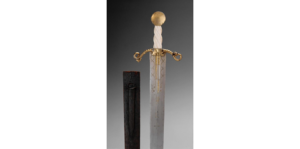
Hungarian treasures in the museums of the world…
Ceremonial sword of the Hungarian Society of the Dragon, about 1433
(Kunsthistorisches Museum Wien, Hofjagd- und Rüstkammer, Austria)

This is the museum’s description of it:
“The medieval ceremonial sword has a gilded two-part ear knob, reminiscent of the oriental Jatagan. Very original is the gilt crossguard in the shape of a dragon, whose natural shape is playfully transformed into a functional one.
Despite the various ends of the monster, the desired symmetry remains largely intact. The multi-tailed tail faces the viper-like bent head, whose deep eye sockets were once filled with color. Between the dentate pines, the rolled-up tongue is visible.
The connecting body center is wider and equipped on each side with two crocodile-like legs. The handle carved out of ivory mimics the meandering of the Narwalzahn, which in the Middle Ages was considered to be the weir of the legendary unicorn.
Four characters and gold-etched tendril patterns can be seen on the broad, tongue-shaped blade on both sides.

This is followed in majuscule writing on the obverse by “REX VNGARIE” and on the opposite side by “COLOMANVS.EPS”, each ending with a cross.
This sword is, therefore, most likely the ceremonial sword of 1408 founded by Sigismund “Society of the Dragon”.
Sigismund moved in 1433 to the coronation of the Emperor in Rome and appointed on the way back, as documented, in Verona and Mantua numerous noblemen to Dragon Knights.

The shape and the extremely early etched decoration of the sword suggest that this was created in northern Italy and can be associated with this appointment of the Dragon Knights.
During his lifetime, Emperor Sigismund had his son-in-law Albrecht V. von Habsburg as heir, over whose son Ladislaus Posthumus the sword finally to the later Emperor Frederick III fell.
Currently not exhibited.”
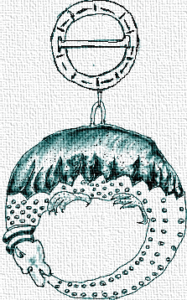
The knights of the Order used to have a greeting when they met:
“O Quam Misericors est Deus, Pius et Justus” (O how merciful is God, faithful and just) In other cases, the knight addressed the other like this: O Quam Misericors est Deus (“Oh, how merciful is God”) and the reply was: “Justus et Paciens” (“Just and patient”)


I feel honored to be connected to a Hungarian Reenactor Association called “Societas Draconistrarum – A Sárkányos Szövetség Lovagjai” (Knights of the Dragon Order). We used to greet each other during our HEMA training as was described above.
https://www.facebook.com/Sarkanyosok/
A few words about the Order of the Dragon:
The Order of the Dragon was a chivalric order founded in 1408 by Sigismund of Luxembourg, King of Hungary 1387–1437, and Holy Roman Emperor 1433–1437. It was fashioned after the military orders of the Crusades, requiring its initiates to defend the cross and fight the enemies of Christianity, in particular the Ottoman Turks.
The founding document of the Order, written in Latin, calls it a society (“societas”) whose members carry the “signum draconis”. (It was also called Gesellschaft mit dem Drachen, Divisa seu Societas Draconica, Societas Draconica seu Draconistarum, and Fraternitas Draconum.
It was to some extent modeled after the earlier Hungarian monarchical order, the Order of St. George (Societas militae Sancti Georgii), founded by King Károly Róbert of Hungary in 1318, the grandfather of Sigismund’s first wife Mary. Another influential model may have been the Sicilian Order of the Ship, founded in 1381.
The order adopted St. George as its patron saint, whose legendary defeat of a dragon was used as a symbol for the military and religious ethos of the order. The other patron saint was St. Margit; she was swallowed by the dragon but God freed her unharmed.
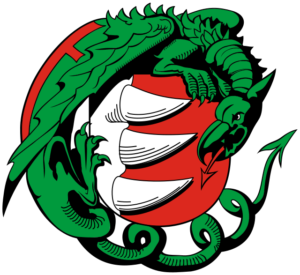
The order aimed to fight the Ottoman Empire, defend the Hungarian monarchy from foreign and domestic enemies, and the Catholic Church from heretics and pagans. It also included foreigners (and non-Catholics), such as the Orthodox Serbian ruler Stefan Lazarević and the Wallachian rulers. Traditionally, the bodyguards or the captains of the Hungarian kings were members of this Order, too. The members were to swear loyalty to the king, queen, and their future sons and to protect the royal interests. In return for their services, the nobles could expect to enjoy royal protection, honors, and offices.
After some time, Sigismund chose to expand the ranks of the Order. The second group of inductees was initiated between 1431 and 1437. As membership grew, the Order of the Dragon came to have two degrees. There was a superior class, which between 1408 and 1418 wore both the dragon and the cross as the Order’s emblem and a more elaborate version afterward. In the first group, the members` number was limited to 24 and they were allowed to wear both the dragon and the cross, while the rest could wear just the dragon; the latter’s number was not limited.
Following Sigismund’s death in 1437, the Order lost prominence. However, the prestigious emblem of the Order was retained on the COA of several Hungarian noble families, including Báthory, Bocskai, Bethlen, Szathmáry, Benyovszky, Kende, and Rákóczi.
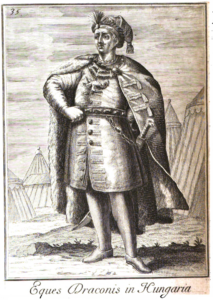
The second ceremonial sword belonged to King Ulászló of Hungary

Sword sent to King Ulászló II, also known as Vladislav II, Władysław II, or Wladislas II (1 March 1456 – 13 March 1516; Czech: Vladislav Jagellonský; Polish: Władysław II Jagiellończyk; Croatian: Vladislav II. Jagelović; Slovak: Vladislav II. Jagelovský), was King of Bohemia from 1471 to 1516, and King of Hungary and Croatia from 1490 to 1516 by Pope Julius II.

Pope Julius II (Italian: Papa Giulio II; Latin: Iulius II) (5 December 1443 – 21 February 1513), born Giuliano della Rovere, and nicknamed “The Fearsome Pope” and “The Warrior Pope”, was head of the Catholic Church and ruler of the Papal States from 1 November 1503 to his death in 1513. He sent this ceremonial sword to the Hungarian king in 1509, a weapon that had never shed blood.

The Diet of 1510 in Hungary was an event combined with a high-level diplomatic meeting, which was probably moved to Tata castle because of the plague threatening Székesfehérvár. Although not all those concerned attended the legislative meeting, most of the politically active nobles were present. The topic also prompted the ambassadors of seven states to travel to Hungary, which was no small undertaking at the time.

www.varlexikon.hu
Such diplomatic events usually involved lavish gifts, and Ulászló II received valuable treasures from foreign envoys. The Roman Pope, through his envoy, presented the king with the consecrated sword at the Holy Mass on 7 July. The head of the Roman Catholic Church intended this ornamental weapon to be an important symbol for the ruler of a country on the East-West frontier during the war against the Turks. The king also received other expensive gifts of gold, silver, jewelry, special fabrics, carpets, and even land from the envoys and the Hungarian lords.

The Diet itself was convened to decide whether the Hungarians should ally with the Western powers against Venice, as they wanted, or whether the alliance should remain with the city-state. The result was a kind of Dodona decision, in which the Kingdom of Hungary formally joined the so-called League of Cambray, but in practice, no Hungarian arms or intrigue were turned against the former good ally Venice.

The Ensis Benedictus, the “blessed sword”
Let us say a few words about the tradition of “Ensis Benedictus” when the Pope awarded a blessed sword to rulers… A sword like this is an object that is consecrated by the reigning Pope at the third mass every Christmas, hence the name Christmas sword. The symbolic sword is a reference to the biblical scene of St Peter drawing a sword to protect Jesus when he was arrested in the Garden of Olives, but it can also refer to the story of Judas Maccabeus.

The future owner was present at the mass, he was to be girded with it and receive the accompanying ermine hat. However, if the designated person was absent, the Papal Legate would hand it over in a special ceremony. The hat, adorned with ermine beads was placed on the tip of the sword, which was then carried by the legate, pointing to the sky, to the place of the handover, where a mass was celebrated in honor of the handover. This important moment defines the original point of view of the sword, which is to be interpreted with the sword pointing downwards.

Generally, such a valuable sword was given to monarchs and other distinguished persons for their service to the Church, but there were also occasions when it was given to an administrative person, as shown by the Swiss sister sword of King Ulászló II. Such a sword, as a symbol of power or as a tool of agitation for an alliance, can be considered more as a work of art, as their appearance attests. It was not designed for combat.

Very few of the many swords that have been consecrated are still preserved in museums. Fortunately, the Hungarian National Museum can boast of an example in excellent condition, but Ulászló II was not the only Hungarian king to be rewarded with such a sword. Kings Ulászló I and Hunyadi Mátyás were also gifted with a blessed blade, but unfortunately, they have been lost over the centuries.

The blades were often ordered in advance from Spanish or Catalan masters, with the Papal engraver only responsible for the engraving. The blades are decorated with the figures of St. Peter and St. Paul, with a long inscription above them indicating the orderer and the year, and a medallion with the boat of Christ at the end.

However, the tradition of giving out the holy sword has now ceased. A sword is blessed at a certain point in the Christmas third Mass, but it is no longer given away. The last papal sword was given to the Duke of Angouleme, blessed by Pope Leo XII in 1825.

Sword with a dragon badge
This sword with a dragon badge was presented by King Sigismund of Hungary to the city of York during his visit to England in 1416:

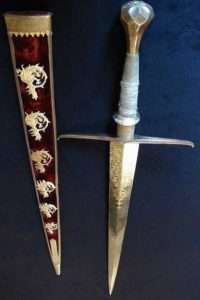
Sources: The Reign of Henry V, vol. Ill (1415-1422) (Cambridge, 1929). p. 35 and Gál, Stephen: Hungary and the Anglo-Saxon World, Picture 3. Sword with a dragon badge, presented by King Sigismund of Hungary to the city of York; Mészáros D. Szimonetta (alias Netta) https://www.arsensis.hu/Kardblog/blog/papai-diszkardokrol/; Magyar Nemzeti Digitális Archívum; zsm https://arhiv.tata.hu/ and MEK oszk https://mek.oszk.hu/02000/02096/html/saxon03.htm
Dear Readers, I can only make this content available through small donations or by selling my books or T-shirts.
If you like my writings, please feel free to support me with a coffee here:
You can check out my books on Amazon or Draft2Digital, they are available in hardcover, paperback, or ebook:
https://www.amazon.com/dp/198020490X
or at https://books2read.com/b/boYd81


My work can also be followed and supported on Patreon: Become a Patron!http://Become a Patron!




